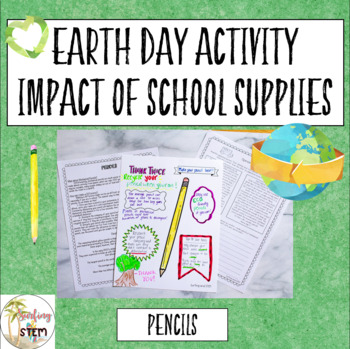Surfing and STEM
469 Followers
Grade Levels
4th - 7th
Subjects
Resource Type
Standards
CCSSRI.5.4
CCSSW.5.1
CCSSW.5.1a
NGSS5-ESS3-1
NGSSMS-ESS3-3
Formats Included
- PDF
Pages
12 pages
Surfing and STEM
469 Followers
Also included in
- This bundle includes everything you need to have a successful earth day in your classroom. Pass out the colorful bookmarks, hang up the earth friendly posters in your classroom reminding students to be mindful of their waste, and take part in impactful, meaningful activities that expose students toPrice $9.20Original Price $11.50Save $2.30
Description
This Earth Day Activity is fun, unique and eye opening for upper grade students. It's also an awesome way to get your kids thinking about marketing with art to create a campaign for Earth Day. This engaging "print and go" lesson takes a deeper look into the impact our school supplies have on the earth. Many supplies are wasted in the classroom and students get involved in the process of educating themselves and others. This is great for any lesson on reducing, reusing, or recycling.
Total Pages
12 pages
Answer Key
Not Included
Teaching Duration
90 minutes
Report this resource to TPT
Reported resources will be reviewed by our team. Report this resource to let us know if this resource violates TPT’s content guidelines.
Standards
to see state-specific standards (only available in the US).
CCSSRI.5.4
Determine the meaning of general academic and domain-specific words and phrases in a text relevant to a grade 5 topic or subject area.
CCSSW.5.1
Write opinion pieces on topics or texts, supporting a point of view with reasons and information.
CCSSW.5.1a
Introduce a topic or text clearly, state an opinion, and create an organizational structure in which ideas are logically grouped to support the writer’s purpose.
NGSS5-ESS3-1
Obtain and combine information about ways individual communities use science ideas to protect the Earth’s resources and environment.
NGSSMS-ESS3-3
Apply scientific principles to design a method for monitoring and minimizing a human impact on the environment. Examples of the design process include examining human environmental impacts, assessing the kinds of solutions that are feasible, and designing and evaluating solutions that could reduce that impact. Examples of human impacts can include water usage (such as the withdrawal of water from streams and aquifers or the construction of dams and levees), land usage (such as urban development, agriculture, or the removal of wetlands), and pollution (such as of the air, water, or land).



